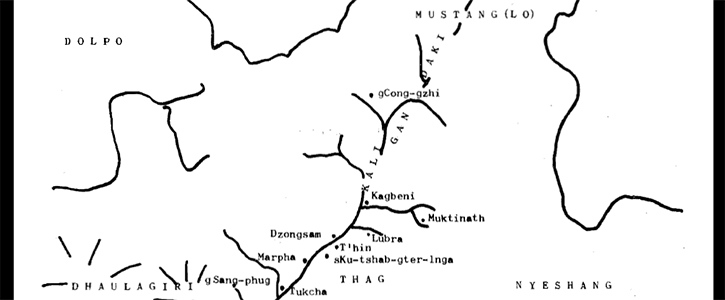
The Kingdom of Lo, the traditional Mustang region and "Upper Mustang" are one and the same, comprising the northern two-thirds of the present-day Nepalese Mustang District They are well-marked by official "Mustang" border signs just north of Kagbeni – where a police post checks permits for non-Nepalese seeking to enter the region – and at Gyu La (pass) east of Kagbeni.
Mustang was once an independent kingdom, although closely tied by language and culture to Tibet. From the 15th century to the 17th century, its strategic location granted Mustang control over the trade between the Himalayas and India. At the end of the 18th century the kingdom was annexed by Nepal. Though still recognized by many Mustang residents, the monarchy ceased to exist on October 7, 2008, by order of the Government of Nepal.The last official and current unofficial king (Raja or gyelpo) is Jigme Dorje Palbar Bista (born c.1933, deceased 2016), who traced his lineage directly back to Ame Pal, the warrior who founded this Buddhist kingdom in 1380. Ame Pal oversaw the founding and building of much of the Lo and Mustang capital of Lo Manthang, a walled city surprisingly little changed in appearance from that time period.
For thousands of years, Mustang Valley has provided one of the few accessible routes across the Himalayan range, between the Vedic culture of India and the Bon culture of Zhang Zhung to the north. Trade and travel by foot and animal continues to this day along the route. As a result, Mustang Valley became a region of co-existence, tolerance and sharing of mystical wisdom between the great spiritual traditions of Bon, Buddhism and Hinduism. Examples of this link are Mount Kailash, which the Bon consider the center of the world, and the spiritual power center of Muktinath which are both considered sacred by all three religions.
Many Bon realized yogis such as Drenpa Namkha, Yangton Tashi Gyaltsen, and others meditated and attained Buddhahood here in this valley. It is said that the great Hindu sage, Valmiki Rishi, wrote the great epic, “Ramayana”, here in the 5th to 4th century A.D. In the 8th century A.D., Mahayana Buddhist practices were brought from India to Tibet along this same route of the Mustang Valley with the visit of Shantarakshita, followed by Padmasambhava and his 25 disciples on their way from India to the land of Tibet. These sages all walked along this corridor along the Kali Gandaki River of the Mustang Valley. The Kali Gandaki or Krishna Gandaki River is one of the major rivers of Nepal and a source of the sacred Ganges River. This was the passageway from India into Tibet, with many pilgrimage sites at the locations of these sages’ realizations.
Bon and the Indo-Tibetan practices have co-existed and flourished in this area for more than a thousand years.
- Mustang Culture and Education Centre
- Successful completion of the Cultural Center in Pangling
- Successful Completion of the Irrigation system to stabilize farming practice
- Successful Completion of the Children's Education System Supportive of Cultural and Spiritual Traditions.
- Mustang Valley Bon Monastery and Spiritual Campus





